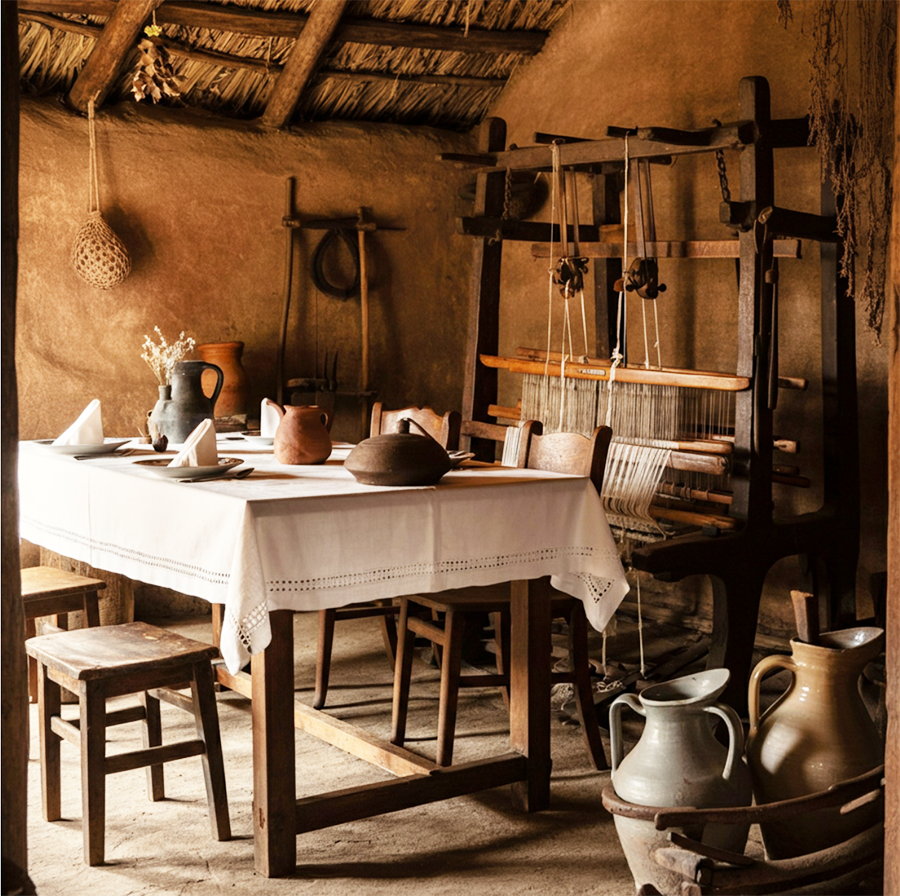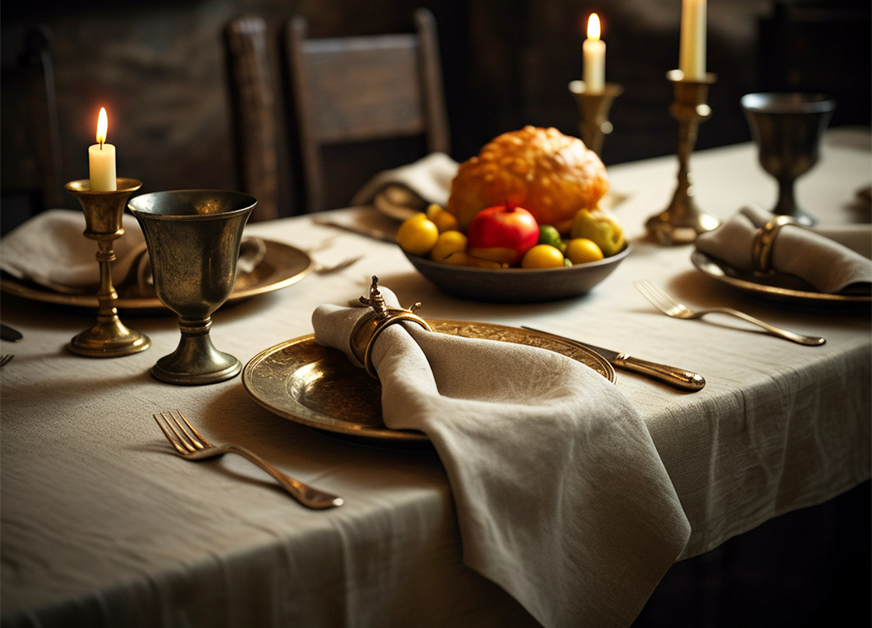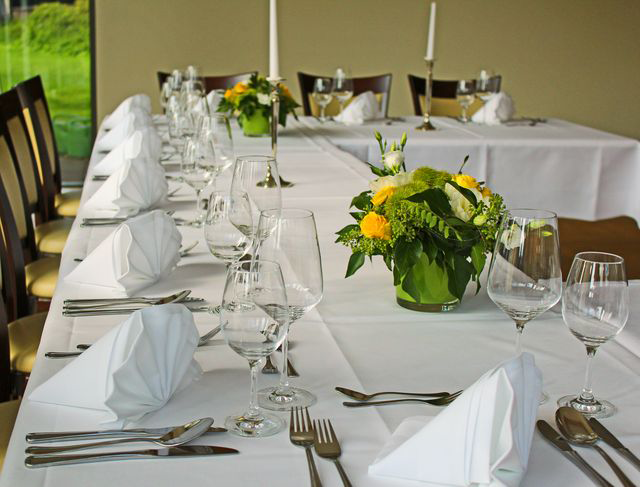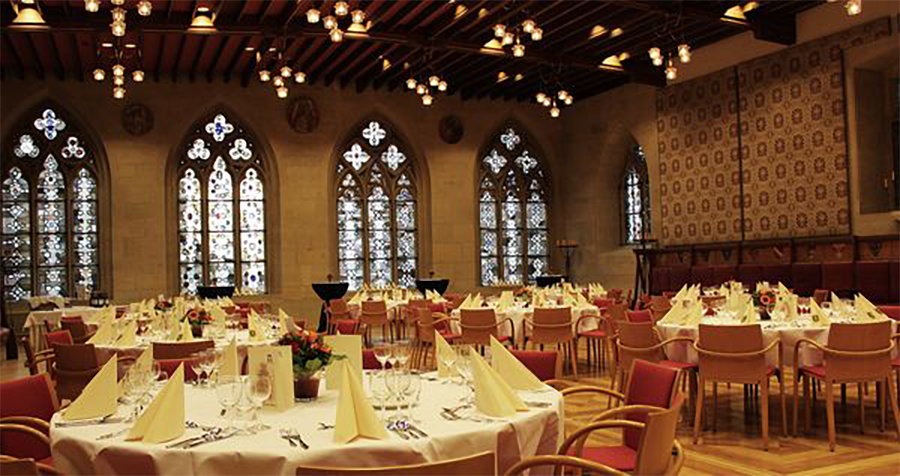Table Culture in Antiquity
As early as ancient Egypt during the time of the Pharaohs, opulent banquets were highly valued
(see Hans Tapper, Der schön gedeckte Tisch, Niedernhausen 1986, pp. 7–11). This is proven by
ancient paintings depicting set tables and dining gatherings.
 Pitchers for drinks, fruit bowls, and platters with food were just as present as musicians who
entertained the guests.
Pitchers for drinks, fruit bowls, and platters with food were just as present as musicians who
entertained the guests.
Similar, though more modest, were the customs of the ancient Greeks.
Their main meal took place in the early evening hours, often consisting of bread dipped in wine,
while meat dishes were less frequently served (see Hans Tapper, Der schön gedeckte Tisch,
Niedernhausen 1986, p. 8). As tableware, cups and plates made of clay or metal were common, and
spoons were used as cutlery. Otherwise, food was eaten with the fingers. Tablecloths
in the modern sense did not exist. Over time, meals in antiquity were no longer taken at tables
but in a reclining position.
This custom was especially popular among the ancient Romans,
as many miniatures from this period illustrate. The Romans also used drinking cups, plates, and
simple cutlery, now including knives for carving meat dishes. New, however, were finger bowls and
napkins (see Hans Tapper, Der schön gedeckte Tisch, Niedernhausen 1986,
pp. 7–11). This shows that napkins as cloths
were already in use in late antiquity. Meals were presented on a small table in the center,
covered with a cloth (see Andreas Morel, Der gedeckte Tisch. Zur Geschichte der Tafelkultur,
Zurich 2001, p. 25). Individual place settings were uncommon, though ownership marks occasionally
appeared on vessels of this time.
Table Culture in the Middle Ages
During the Middle Ages, table culture and dining manners
initially became much simpler and rougher. People mainly used cups,
knives, and occasionally simple forks. Plates, finger bowls, or
napkins and tablecloths
were rarely in use. Instead, meals were eaten from hollowed-out areas in the table,
usually with the fingers. In noble circles, only the thumb, index finger,
and middle finger were used (cf. Hans Tapper, *Der schön gedeckte Tisch*, Niedernhausen 1986, p. 8).
Table linen and tablecloths did not exist at first. Only in the late Middle Ages did
cloths attached to the table appear, which guests could use to wipe their hands and mouths. These
 table cloths can be seen as the forerunners of today’s cloth napkins
and dinner napkins.
table cloths can be seen as the forerunners of today’s cloth napkins
and dinner napkins.
Around 1200, the first medieval manuscripts began to show tables covered with
textiles such as tablecloths and napkins. A well-known example is the
*Hortus deliciarum* by Abbess Herrad of Landsberg, dated 1196
(cf. Gisela Jaacks, "Wenn blendend weiss die Wäsche lacht", in: *Beruf der Jungfrau*, Oberhausen 1988, pp.178f).
These early illustrations typically show a plain tablecloth covering the tabletop,
often made of linen.
A second, richly draped cloth was laid over the edges and usually reached to the floor.
Guests used this surrounding cloth as a napkin for their hands and mouths and also spread it over their laps
to protect their clothing. In this sense, the medieval tablecloth was originally used as a napkin.
Over time, the tablecloth or so-called “table carpet” also took on decorative purposes,
unlike the napkin (cf. Sonja Stummerer & Martin Hablesreiter, *Wie wir essen*, Cologne 2021, pp.98ff).
Table Culture in the Modern Era
In the 16th and 17th centuries, not only
tablecloths
were found on the dining table, but also forks became common – first in Italy, later in France and Germany.
 The spread of forks during the Renaissance and early modern period can possibly be explained by fashion trends:
especially in Italy and the Netherlands, wide lace collars were in style. Many paintings of noble families
and banquets – particularly those by the Dutch painter Frans Hals – show this clearly.
To avoid staining these elaborate collars, forks were increasingly used.
The spread of forks during the Renaissance and early modern period can possibly be explained by fashion trends:
especially in Italy and the Netherlands, wide lace collars were in style. Many paintings of noble families
and banquets – particularly those by the Dutch painter Frans Hals – show this clearly.
To avoid staining these elaborate collars, forks were increasingly used.
In France, the custom of eating with both knife and fork probably became established first.
The dining manners that developed during this period have continued to shape our table culture
to this day.
From the aristocratic courts, these table manners spread to the wider population
during the 18th century. In the 19th and 20th centuries, dining culture refined even further:
meals became more varied and sophisticated, tableware more valuable, and silver cutlery grew fashionable.
By the late 19th century, elaborate table-setting rules and a complex etiquette for formal occasions
were firmly established (cf. Tessa Everlegh, *Der schöne Tisch*, Munich 1999, p. 6).
In addition, special utensils such as fish cutlery, soup spoons, and even egg cups were introduced.
For further reading, please see our
literature list.

